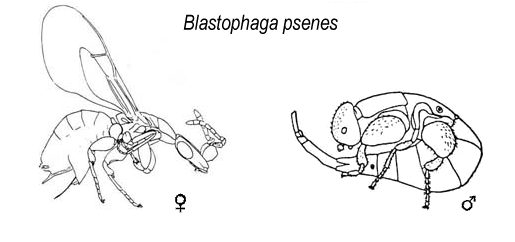|
Robertsia
''Robertsia'' is a genus of fig wasps in the family Pteromalidae The Pteromalidae are a very large family of mostly parasitoid wasps, with some 3,450 described species in about 640 genera (the number was greater, but many species and genera have been reduced by synonymy in recent years). The subfamily-level d ..., native to Papua New Guinea. References Hymenoptera genera Pteromalidae {{Chalcidoidea-stub ... [...More Info...] [...Related Items...] OR: [Wikipedia] [Google] [Baidu] |
Fig Wasp
Fig wasps are wasps of the superfamily Chalcidoidea which spend their larval stage inside figs. Most are pollinators but others simply feed off the plant. The non-pollinators belong to several groups within the superfamily Chalcidoidea, while the pollinators are in the family Agaonidae. While pollinating fig wasps are gall-makers, the remaining types either make their own galls or usurp the galls of other fig wasps; reports of their being parasitoids are considered dubious. History Aristotle recorded in his ''History of Animals'' that the fruits of the wild fig (the caprifig) contain ''psenes'' (fig wasps); these begin life as grubs (larvae), and the adult ''psen'' splits its "skin" (pupa) and flies out of the fig to find and enter a cultivated fig, saving it from dropping. He believed that the ''psen'' was generated spontaneously; he did not recognise that the fig was reproducing sexually and that the ''psen'' was assisting in that process. Taxonomy The fig wasps are a pol ... [...More Info...] [...Related Items...] OR: [Wikipedia] [Google] [Baidu] |
Pteromalidae
The Pteromalidae are a very large family of mostly parasitoid wasps, with some 3,450 described species in about 640 genera (the number was greater, but many species and genera have been reduced by synonymy in recent years). The subfamily-level divisions of the family are highly contentious and unstable, and the family is thought to be "artificial", composed of numerous, distantly related groups (polyphyletic). Accordingly, details of their life histories range over nearly the entire range possible within the Chalcidoidea, though the majority are (as with most chalcidoids) parasitoids of other insects. They are found throughout the world in virtually all habitats, and many are important as biological control agents. The oldest known fossil is known from the Early Cretaceous. In essence, a "pteromalid" is any member of the Chalcidoidea that has five-segmented tarsi and does not have the defining features of any of the remaining families with five-segmented tarsi. It is highly prob ... [...More Info...] [...Related Items...] OR: [Wikipedia] [Google] [Baidu] |
Hymenoptera Genera
Hymenoptera is a large order of insects, comprising the sawflies, wasps, bees, and ants. Over 150,000 living species of Hymenoptera have been described, in addition to over 2,000 extinct ones. Many of the species are parasitic. Females typically have a special ovipositor for inserting eggs into hosts or places that are otherwise inaccessible. This ovipositor is often modified into a stinger. The young develop through holometabolism (complete metamorphosis)—that is, they have a wormlike larval stage and an inactive pupal stage before they mature. Etymology The name Hymenoptera refers to the wings of the insects, but the original derivation is ambiguous. All references agree that the derivation involves the Ancient Greek πτερόν (''pteron'') for wing. The Ancient Greek ὑμήν (''hymen'') for membrane provides a plausible etymology for the term because species in this order have membranous wings. However, a key characteristic of this order is that the hindwings are co ... [...More Info...] [...Related Items...] OR: [Wikipedia] [Google] [Baidu] |

